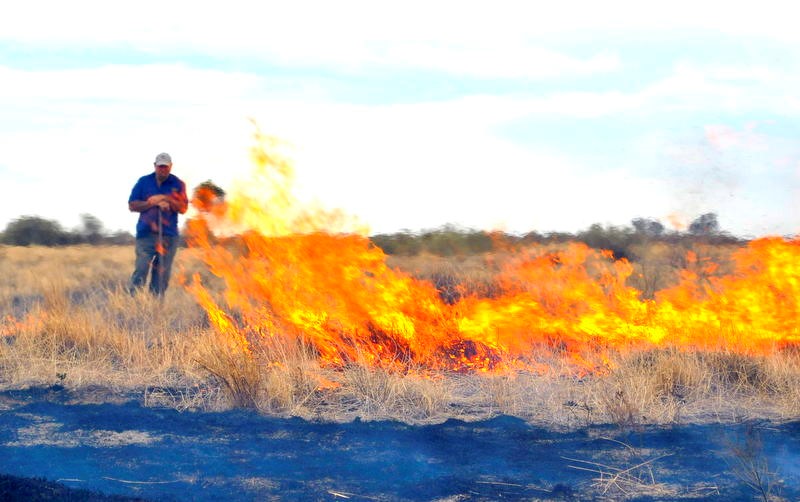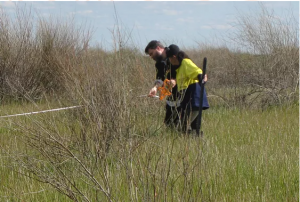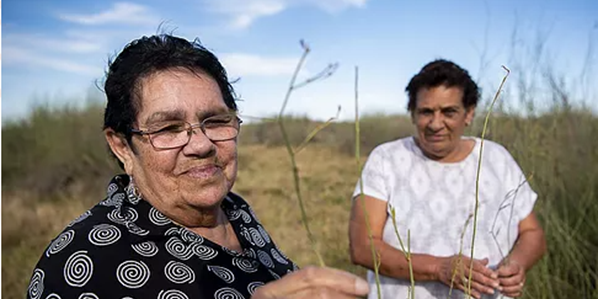Nari Nari Tribal Council
Nari Nari Tribal Council was formed in 2000 by a group of Aboriginal people interested in the protection of both Indigenous culture and history.
For further information on the Nari Nari Tribal Council, view their website here.
Protection of Aboriginal heritage sites at Gayini (Nimmie Caira)
Aboriginal sites at Gayini have been identified and protected as part of the Nari Nari Tribal Council’s ongoing land management works On Country. Staff, Elders and members inspect areas of interest, and record new sites on the NSW AHMS register. If sites include exposed burial remains they are covered with soil from nearby, and branches are laid across to slow the passage of water, and the degrading effects of wind. Seed is collected from the immediate area (saltbushes, other low shrubs and acacia species) then scattered across the site. If appropriate, a small fire is lit, and a smoking ceremony conducted, to cleanse the area.
 The entire Gayini area is a rich cultural landscape that has supported Aboriginal people for 50,000 years. The property is home to a wealth of Indigenous cultural features from sacred canoe scar trees to ancient burial mounds and camp sites. For thousands of years the First Australians in this area made interventions to boost the productivity of their Country – enhancing fish and bird stocks, and vegetation growth. Once more in possession of their land, Nari Nari people are caring for it using a combination of traditional and modern techniques to improve its productivity and enhance its values.
The entire Gayini area is a rich cultural landscape that has supported Aboriginal people for 50,000 years. The property is home to a wealth of Indigenous cultural features from sacred canoe scar trees to ancient burial mounds and camp sites. For thousands of years the First Australians in this area made interventions to boost the productivity of their Country – enhancing fish and bird stocks, and vegetation growth. Once more in possession of their land, Nari Nari people are caring for it using a combination of traditional and modern techniques to improve its productivity and enhance its values.
The Gayini project has provided full-time employment for five local people, part-time employment for two people and casual labour and training opportunities for an additional six people. Aboriginal people make up 70% of Nari Nari Tribal Council employment. This has led to an increase in economic opportunities for these individuals, as well as increased skills and qualifications such as first aid and chemical handling. It has also allowed Elders to do traditional practices, such as cultural burning, and actively protect Cultural assets.
The ecological significance of Gayini
Gayini is part of the Lowbidgee floodplain – the largest remaining area of wetlands in the Murrumbidgee Valley, within the southern Murray-Darling Basin. It’s an area of national and international conservation significance. Native Australian birds are particularly abundant here ranging in size from the tiny Spotted Pardalote to big, impressive Emus in large numbers. Of highest significance, the wetlands provide feeding and breeding habitat for many different species of freshwater birds which can amass in large nesting colonies when conditions are right – species like the Straw-necked Ibis, Royal Spoonbill, Little Pied Cormorant and Australian Pelican.
Nationally listed threatened species are also protected at Gayini including
one of Australia’s largest frogs – the Southern Bell Frog, and two endangered bird species – the Australasian Bittern and Australian Painted-snipe. In November 2019, the critically endangered Plains-wanderer was seen and photographed, a first for Gayini. This unique species relies on native grasslands that are well managed with not too much grazing but not too little.
While around half of the property was previously used for cropping and grazing over the last 150 years, the majority of it remains covered with significant native vegetation in good or recovering condition. Gayini’s management plan permanently protects these habitats for the wealth of species that rely on them for their survival.
The importance of partnerships
 Nari Nari Tribal Council partners with consortium organisations including the University of NSW, Murray Darling Wetland Working Group and the Nature Conservancy (Australia) to manage Gayini. In addition, project partners such as CSIRO and Charles Sturt University are welcomed to undertake monitoring On Country, and from who NNTC staff are able to be mentored.
Nari Nari Tribal Council partners with consortium organisations including the University of NSW, Murray Darling Wetland Working Group and the Nature Conservancy (Australia) to manage Gayini. In addition, project partners such as CSIRO and Charles Sturt University are welcomed to undertake monitoring On Country, and from who NNTC staff are able to be mentored.
Working with Landcare gives Nari Nari Tribal Council access to a wide network of experienced and knowledgeable landowners, which allows everyone to learn from each other, through open communication and relationships within the community. NNTC works with Hay Plains Landcare to promote each other’s activities, and to provide networking opportunities. With Landcare, NNTC have been able to participate in workshops on topics such as soil management and seed propagation, allowing members to share traditional land management techniques such as cultural burning and seed broadcasting. Being able to be in quick contact with the Bidgee West Local Landcare Coordinator for advice and expertise has been a key contact for the organisation.
The Gayini Land Management Expo is a fantastic example of the ways in which the Nari Nari Tribal Council are working together with Landcare and others to share their knowledge of Indigenous land management.
A big congratulations to Nari Nari Tribal Council!!!








